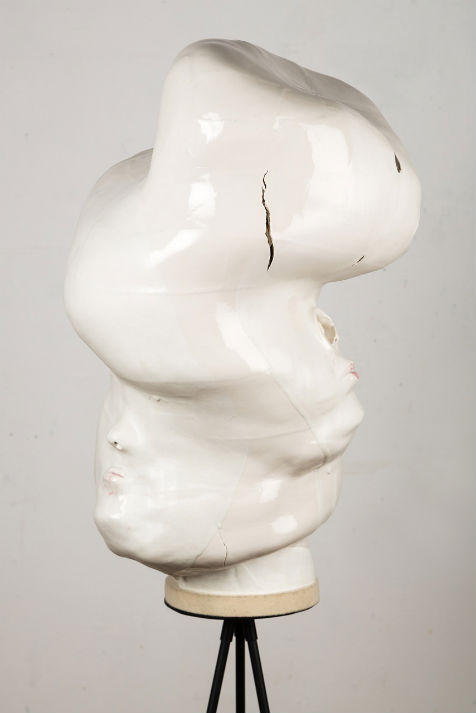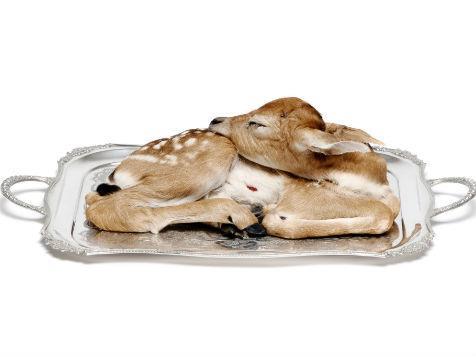Julia DeVille, Sorrow, 2013. Image courtesy of Woollahra Small Sculpture Prize.
Sculpture began its life as a monumental art form but sometimes sculptures of a more intimate size can speak volumes. The Woollahra Small Sculpture Prize has a reputation for showing the power of the diminutive.
Judge Justin Miller said the competition offered a unique platform for artists across the country to present small sculpture works to the broader community.
‘Sculpture is becoming increasingly collected – people love sculpture and it’s [the Prize] a wonderful way for people to see sculpture that would perhaps work in a domestic setting. Sometimes you only see very large sculptures in the public domain, which can be a little intimidating. Yet sculpture can also be very small,’ said Miller
Established by Woollahra Council in 2001, the Woollahra Small Sculpture Prize attracts strong support from artists, collectors and critics, and is the only national acquisitive prize showcasing the quality and diversity of smaller dimension sculptures.
‘It’s one of those prizes that’s garnered great respect within the artistic community. When artists are considering what prizes they should enter, I think that it’s important they look at prizes that have great appeal and are respected by the community,’ he said.
‘There’s certainly wonderful sculpture that is entered. In previous years, over 400 people have entered and then of course we have to narrow that down to a smaller group.’
Miller said the opportunity to award multiple prizes was a great opportunity for judges as well as for the recipient. ‘Often when you are judging prizes, it’s very difficult because there’s only one prize, but in this competition there’s actually four prizes which is fantastic.’
The Prize attracts a diverse range of professional and emerging sculptors from around the world with a total of $19,000 in prize money awarded to winning artists across four categories.
As well as the major Acquisitive Award of $15,000 – increased from $10,000 – this year’s categories include a Special Commendation award of $2,000, the Viewers’ Choice award of $1,000 and, for the first time, a new Mayor’s Award of $1,000.
Joining Miller on this year’s judging panel is Carriageworks Director Lisa Havilah and philanthropist Gretel Packer. They will assess the skill and craftsmanship of the work, the inspiration and vision behind the piece, and the strength of the sculpture itself.
‘It’s very important to be open-minded in something like this, and be willing to be surprised. All the judges have a keen interest in sculpture and are very keen to support and promote the sculptures in the community,’ said Miller.

Michelle Ussher, Geyron. 2013 Woollahra Small Sculpture Prize Special Commendation Award.
In 2013, more than 480 entries from national and international artists were received and around 40 finalists’ works were presented in the exhibition. ‘It’s fostered a number of sculptors who have really gone on to continue becoming increasingly well-known and popular in the art world.’
‘Alexander Seton won several years ago [2009] and is a very keenly sought (after) sculptor. Louis Pratt is also very popular – it gives sculptors great exposure, and I think that sculpture is something that is increasingly popular with collectors,’ said Miller.
Notable past winners also include Jan King (2002), Mikala Dwyer (2003), Adam Cullen (2008), Archie Moore (2010) and Thor Beowulf (2012).
Last year’s winner, Melbourne taxidermy artist Julia DeVille, was inspired to enter the competition with Sorrow following two Viewers’ Choice wins, with Ego Verto (2010) and Lenore (2011).
‘It’s a great little sculpture prize. I had a good piece that I thought had a possibility of winning, and it did,’ she said.
Sorrow is a taxidermy stillborn deer sleeping on an ornate silver platter, with a wound of rubies. ‘I’m a vegan and an animal rights activist – my works are all quite strongly animal rights themed.
‘This sculpture is identifying with the animals that we consume, and not just seeing them as a commodity or something that comes wrapped in Styrofoam and glad wrap,’ she said.
Since taking out the prize, DeVille has worked steadily for the last 12 months with her recent exhibition Degustation at the NGV as apart of Melbourne Now, and Phantasmagoria, which featured at the Art Gallery of South Australia during the 2014 Adelaide Biennial.
In September, she has a solo show coming up at the Sophie Gannon gallery alongside Lesley Rice.
DeVille said the exposure from the Woollahra Small Sculpture Prize has created opportunities to put on bigger shows, aided by the financial support of the prize money.
‘There’s not actually that many prizes for sculpture, which is unfortunate. There’s a lot of outdoor sculpture prizes, and a lot of portrait prizes, but in terms of small sculpture, Woollahra is the only one that I know of – it’s really important in that sense because it’s allowing artists to work in that medium.
‘It brings artwork to a wider audience, it exposes people to things that they haven’t seen before, and it also helps promote the artist with media coverage, and prize money if they win. It’s a valuable thing and it contributes a lot.’
DeVille’s advice to artists wanting to submit is to simply enter a piece that speaks honestly. ‘In the past when I had only been a finalist, or maybe won the Viewers’ Choice, it hadn’t been the strongest possible work that I could have submitted. It’s important to put something that you consider to be a really strong piece. It’s just chance after that if the judges happen to be aligned with you.’
Entries to the Woollahra Small Sculpture Prize are currently open until 25 July 2014.
A free exhibition of finalist works will be presented from 18 October until 2 November 2014 at Woollahra Council Chambers in Sydney.
Artists submitting to the prize are required to include images of their proposed or completed original freestanding sculpture up to 80cm in any dimension.
For more information visit the Woollahra Small Sculpture Prize website.





